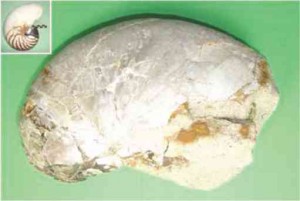The chambered nautilus
A mollusk that is closely related to the squid, cuttlefish and octopus, the chambered nautilus has a cream-colored, spiral-shaped shell adorned with chocolaty-brown stripes.
What is intriguing about this animal is that it has about 90 tentacles on its head.
The beautiful creature is known to live in the deep waters of tropical Indo–Pacific.
Considered a living fossil, it is believed that animals belonging to the genus Nautilus diversified some 40 or 30 million years ago then died out. It appeared again after several million years as the modern nautilus.
To date, no fossil of the nautilus that thrived between 10,000 to 25 million years has been unearthed anywhere in the world, except for a 10,000-year-old Nautilus pompilius fossil collected from uplifted organic sediments in Leyte and the 2-million-year-old N. pompilius fossil found in a siltstone rock off the coast of Pangasinan.
Article continues after this advertisementThe fossil nautilus from Pangasinan truly withstood the test of time and bore the diagnostic features that characterize the modern N. pompilius.
Article continues after this advertisementThe coiling of shell is the same and the size of the whorl’s central cavity, relative to shell diameter, is small just like in the modern N. pompilius.
Based on its characteristics and age, the chambered nautilus fossil from Pangasinan is so far the oldest Nautilus pompilius fossil ever known.
Roberto SP. de Ocampo
National Museum of Natural History
E-mail: [email protected]
